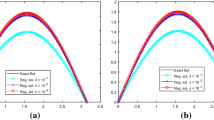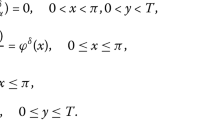Abstract
In this paper, a Cauchy problem for the Helmholtz equation is investigated. It is well known that this problem is severely ill-posed in the sense that the solution (if it exists) does not depend continuously on the given Cauchy data. To overcome such difficulties, we propose a modified regularization method to approximate the solution of this problem, and then analyze the stability and convergence of the proposed regularization method based on the conditional stability estimates. Finally, we present two numerical examples to illustrate that the proposed regularization method works well.






Similar content being viewed by others
References
Beskos, D.E.: Boundary element methods in dynamic analysis: part II (1986–1996). Appl. Mech. Rev. 50, 149–197 (1997)
Chen, J.T., Wong, F.C.: Dual formulation of multiple reciprocity method for the acoustic mode of a cavity with a thin partition. J. Sound. Vib. 217, 75–95 (1998)
Hall, W.S., Mao, X.Q.: Boundary element investigation of irregular frequencies in electromagnetic scattering. Eng. Anal. Bound. Elem. 16, 245–252 (1995)
Harari, I., Barbone, P.E., Slavutin, M., Shalom, R.: Boundary infinite elements for the Helmholtz equation in exterior domains. Int. J. Numer. Methods Eng. 41, 1105–1131 (1998)
Arendt, W., Regińska, T.: An ill-posed boundary value problem for the Helmholtz equation on Lipschitz domains. J. Inverse Ill-Posed Probl. 17, 703–711 (2009)
Chen, G., Zhou, J.: Boundary Element Methods. Computational Mathematics and Applications. Academic Press, London (1992)
Regińska, T., Regiński, K.: Approximate solution of a Cauchy problem for the Helmholtz equation. Inverse Probl. 22, 975–989 (2006)
Hadamard, J.: Lectures on Cauchy’s Problem in Linear Partial Differential Equations. Yale University Press, New Haven (1923)
Isakov, V.: Inverse Problems for Partial Differential Equations. Applied Mathematical Sciences, vol. 127. Springer, New York (1998)
Tikhonov, A.N., Arsenin, V.Y.: Solutions of Ill-Posed Problems, V. H. Winston & Sons, Washington, DC: John Wiley & Sons, New York (1977)
Engl, H.W., Hanke, M., Neubauer, A.: Regularization of Inverse Problems. Mathematics and Its Applications, vol. 375. Kluwer Academic, Dordrecht (1996)
Kirsch, A.: An Introduction to the Mathematical Theory of Inverse Problems. Applied Mathematical Sciences, vol. 120. Springer, New York (2011)
Cheng, H., Fu, C.L., Feng, X.L.: An optimal filtering method for the Cauchy problem of the Helmholtz equation. Appl. Math. Lett. 24, 958–964 (2011)
Feng, X.L., Fu, C.L., Cheng, H.: A regularization method for solving the Cauchy problem for the Helmholtz equation. Appl. Math. Model. 35, 3301–3315 (2011)
Fu, C.L., Feng, X.L., Qian, Z.: The Fourier regularization for solving the Cauchy problem for the Helmholtz equation. Appl. Numer. Math. 59, 2625–2640 (2009)
Jin, B.T., Marin, L.: The plane wave method for inverse problems associated with Helmholtz-type equations. Eng. Anal. Bound. Elem. 32, 223–240 (2008)
Jin, B.T., Zheng, Y.: Boundary knot method for some inverse problems associated with the Helmholtz equation. Int. J. Numer. Methods Eng. 62, 1636–1651 (2005)
Marin, L., Elliott, L., Heggs, P.J., Ingham, D.B., Lesnic, D., Wen, X.: Conjugate gradient-boundary element solution to the Cauchy problem for Helmholtz-type equations. Comput. Mech. 31, 367–377 (2003)
Marin, L., Elliott, L., Heggs, P.J., Ingham, D.B., Lesnic, D., Wen, X.: BEM solution for the Cauchy problem associated with Helmholtz-type equations by the Landweber method. Eng. Anal. Bound. Elem. 28, 1025–1034 (2004)
Marin, L., Elliott, L., Heggs, P.J., Ingham, D.B., Lesnic, D., Wen, X.: Comparison of regularization methods for solving the Cauchy problem associated with the Helmholtz equation. Int. J. Numer. Methods Eng. 60, 1933–1947 (2004)
Marin, L., Lesnic, D.: The method of fundamental solutions for the Cauchy problem associated with two-dimensional Helmholtz-type equations. Comput. Struct. 83, 267–278 (2005)
Qin, H.H., Wei, T.: Modified regularization method for the Cauchy problem of the Helmholtz equation. Appl. Math. Model. 33, 2334–2348 (2009)
Regińska, T., Wakulicz, A.: Wavelet moment method for the Cauchy problem for the Helmholtz equation. J. Comput. Appl. Math. 223, 218–229 (2009)
Sun, Y., Zhang, D.Y., Ma, F.M.: A potential function method for the Cauchy problem of elliptic operators. J. Math. Anal. Appl. 395, 164–174 (2012)
Wei, T., Hon, Y.C., Ling, L.: Method of fundamental solutions with regularization techniques for Cauchy problems of elliptic operators. Eng. Anal. Bound. Elem. 31, 373–385 (2007)
Xiong, X.T., Zhao, X.C., Wang, J.X.: Spectral Galerkin method and its application to a Cauchy problem of Helmholtz equation. Numer. Algorithms 63, 691–711 (2013)
Zhang, H.W., Qin, H.H., Wei, T.: A quasi-reversibility regularization method for the Cauchy problem of the Helmholtz equation. Int. J. Comput. Math. 88, 839–850 (2011)
Xiong, X.T.: A regularization method for a Cauchy problem of the Helmholtz equation. J. Comput. Appl. Math. 233, 1723–1732 (2010)
Han, H., Reinhardt, H.J.: Some stability estimates for Cauchy problems for elliptic equations. J. Inverse Ill-Posed Probl. 5, 437–454 (1997)
Tautenhahn, U.: Optimal stable solution of Cauchy problems for elliptic equations. J. Anal. Appl. 15, 961–984 (1996)
Cheng, J., Yamamoto, M.: One new strategy for a priori choice of regularizing parameters in Tikhonov’s regularization. Inverse Probl. 16, L31–L38 (2000)
Kabanikhin, S.I., Schieck, M.: Impact of conditional stability: convergence rates for general linear regularization methods. J. Inverse Ill-Posed Probl. 16, 267–282 (2008)
Hào, D.N., Van Duc, N., Lesnic, D.: A non-local boundary value problem method for the Cauchy problem for elliptic equations. Inverse Probl. 25, 055002 (2009)
Wei, T., Qin, H.H., Zhang, H.W.: Convergence estimates for some regularization methods to solve a Cauchy problem of the Laplace equation. Numer. Math. Theor. Methods Appl. 4, 459–477 (2011)
Qin, H.H., Wei, T.: Some filter regularization methods for a backward heat conduction problem. Appl. Math. Comput. 217, 10317–10327 (2011)
Showalter, R.E.: Cauchy problem for hyper-parabolic partial differential equations. In: Lakshmikantham, V. (ed.) Trends in the Theory and Practice of Non-Linear Analysis. Elsevier, North-Holland (1985)
Ames, K.A., Clark, G.W., Epperson, J.F., Oppenheimer, S.F.: A comparison of regularizations for an ill-posed problem. Math. Comput. 67, 1451–1471 (1998)
Acknowledgments
The authors would like to thank the reviewers’ valuable comments and suggestions that have improved our manuscript. The work described in this paper was supported in part by the Fundamental Research Funds for the Central Universities (2015QNA49).
Author information
Authors and Affiliations
Corresponding author
Additional information
Communicated by Dongwoo Sheen.
Appendices
Appendix 1
Proof to Lemma 2.2
The proof is inspired by the idea of [13]. The condition \(\left\| v(\cdot ,1)\right\| \le E\) leads to
The condition \(\left\| \phi \right\| \le \varepsilon \) means
Now define a function \(\tau _1(y)\) as
where \(N_1=\min \left\{ n|\cosh \left( \sqrt{n^2-k^2}y\right) \ge m_1(y), n>k\right\} \) and \(m_1(y)=(1-y)(2E)^y\varepsilon ^{-y}\). Denote \(\xi =\sqrt{n^2-k^2}\) for \(n>k\). From (2.3), we have
Further, from (7.1) and (7.2), we have
where
In the following, we estimate \(A_1(n)\).
Note that \(F(\xi )=\frac{\mathrm{{e}}^{\xi y}-m_1(y)}{\mathrm{{e}}^\xi }\) over \(\xi >0\) attains its maximum \(F_{\mathrm{{max}}}=y(1-y)^{\frac{1}{y}-1}\left( m_1(y)\right) ^{-\left( \frac{1}{y}-1\right) }\), then we have
Meanwhile, note that \(\left| \tau _1(y)\right| \le m_1(y)\) for \(n>k\), thus we have
It is easy to check that the function \(F_1(m_1)=2Ey(1-y)^{\frac{1}{y}-1}\left( m_1(y)\right) ^{-\left( \frac{1}{y}-1\right) }+\varepsilon m_1(y)\) reaches its minimum at \(m_1(y)=(1-y)(2E)^y\varepsilon ^{-y}\). Hence, by (7.3), we have
\(\square \)
Appendix 2
Proof to Lemma 2.3
The condition \(\left\| w(\cdot ,1)\right\| \le E\) is equivalent to
The condition \(\left\| \psi \right\| \le \varepsilon \) means
Define the following function
where \(N_2\!=\!\min \left\{ n\mid \frac{\sinh \left( \sqrt{n^2-k^2}y\right) }{\sqrt{n^2-k^2}} \ge m_2(y),n\!>\!k \right\} \), note that \(g(n)=\frac{\sinh \left( \sqrt{n^2-k^2}y\right) }{\sqrt{n^2-k^2}}\) is strictly monotonically increasing for \(n>k\), and \(m_2(y)=\left( 1-\mathrm{{e}}^{-2\rho }\right) ^{-y}(2\rho )^{-(1-y)}(1-y)E^y\varepsilon ^{-y}\), where \(\rho =\sqrt{\left( [k]+1\right) ^2-k^2}\). Taking the similar procedure of estimating \(\left\| v(\cdot ,y)\right\| \), from (2.4), (8.1) and (8.2), note that \(\left| \tau _2(y)\right| \le m_2(y)\) for \(n>k\), we have
where
Now we firstly estimate \(A_2(n)\).
By a simple calculation, we can obtain that \(G(\xi )=\frac{\mathrm{{e}}^{\xi y}-2\rho m_2(y)}{\mathrm{{e}}^\xi }\) over \(\xi >0\) attains its maximum \(G_{\max }=(2\rho )^{-(\frac{1}{y}-1)} y(1-y)^{\frac{1}{y}-1}\left( m_2(y)\right) ^{-\left( \frac{1}{y}-1\right) }\). Then, we have
It is easy to check that the function \(F_2(m_2)=\left( 1-\mathrm{{e}}^{-2\rho }\right) ^{-1}(2\rho )^{-(\frac{1}{y}-1)}Ey(1-y)^{\frac{1}{y}-1}\left( m_2(y)\right) ^{-\left( \frac{1}{y}-1\right) }+\varepsilon m_2(y)\) reaches its minimum at \(m_2(y)=\left( 1-\mathrm{{e}}^{-2\rho }\right) ^{-y}(1-y)(2\rho )^{-(1-y)}E^y\varepsilon ^{-y}\). Hence, using the inequality \(1-\mathrm{{e}}^{-r}\le r\) for \(r \ge 0\), we obtain
\(\square \)
Appendix 3
Proof to Theorem 2.5
In the following, we firstly estimate \(\Vert v(\cdot , 1)\Vert \), whose proof is inspired by the idea of paper [22]. By (2.3), the condition \(\left\| \frac{\partial ^p v(\cdot ,1)}{\partial y^p} \right\| \le E_p\) leads to
Denote \(\zeta =\sqrt{k^2-n^2}\) for \(n \le k\), \(\xi =\sqrt{n^2-k^2}\) for \(n>k\), \(\nu =\left( \ln \left( \frac{E_p}{\varepsilon } \left( \ln \frac{E_p}{\varepsilon }\right) ^{-p}\right) \right) ^{-1}\) and \({\gamma }=\frac{\xi }{\sqrt{1+\nu ^2n^2}}\). Note that \(\frac{\cosh (\xi )}{\sinh (\xi )}=\frac{e^\xi +e^{-\xi }}{e^\xi \left( 1-e^{-2\xi }\right) }\le \frac{2}{1-\mathrm{{e}}^{-2\rho }}\), where \(\rho =\sqrt{\left( [k]+1\right) ^2-k^2}\).
For the case of \(k\ge 1\), from (2.3), (7.2) and (9.1), we have
where
For D(n), we have \(D(n) \le \mathrm{{e}}^{\gamma }\le \mathrm{{e}}^{\frac{1}{\nu }}\). In the following, we estimate B(n). Note that \(\xi > \gamma \), we have
Case 1 For large values of n with \(\xi =\sqrt{n^2 -k^2} \ge \nu ^{-\frac{2}{3}}\), we have
Case 2 For \(\xi < \nu ^{-\frac{2}{3}}\), note that \(\xi -\gamma \le \frac{1}{2} \nu ^2 n^2\xi \) and \(1-\mathrm{{e}}^{-r}\le r\) for \(r\ge 0\) , we have
-
(1)
For \(n=[k]+1\), by (9.2), \(B(n) \le \frac{1}{2}\nu ^2([k]+1)^2\rho ^{1-p}\);
-
(2)
For \(n >[k]+1\), by (9.2), note that \(\xi >1\),
-
(a)
If \(0< p <3\), \(B(n) \le \frac{1}{2}(1+k^2)\nu ^2 \xi ^{3-p} \le \frac{1}{2}(1+k^2)\nu ^{\frac{2p}{3}}\);
-
(b)
If \(p \ge 3\), \(B(n) \le \frac{1}{2}(1+k^2)\nu ^2\).
Hence, by cases 1 and 2, we obtain that
Now combining the above discussion, we have
For the case of \( 0 < k < 1\), the first term in the right-hand side of Eq. (9.4) can be vanished.
Now we estimate \(\Vert w(\cdot , 1)\Vert \). By (2.4), the condition \(\left\| \frac{\partial ^p w(\cdot ,1)}{\partial y^p} \right\| \le E_p\) leads to
Taking the similar procedure of estimating \(\left\| v(\cdot ,1)\right\| \), when \(k\ge 1\), recalling that \(\gamma =\xi /\sqrt{1+\nu ^2n^2}\), we have
where
Recalling that \(1-\mathrm{{e}}^{-r}\le r\) for \(r\ge 0\), we have
In the following, we estimate \(B_1(n)\).
Case 1 For large values of n with \(\xi =\sqrt{n^2 -k^2} \ge \nu ^{-\frac{2}{3}}\), using Taylor expansion \(\sinh (s)=\sum _{n=1}^{\infty }\frac{s^{2n-1}}{(2n-1)!}\), recalling that \(\gamma =\xi /\sqrt{1+\nu ^2n^2}\), we get \(\sqrt{1+\nu ^2n^2}\frac{\sinh (\gamma )}{\sinh (\xi )}<1\), hence
Case 2 For \(\xi <\nu ^{-\frac{2}{3}}\), we have
where \(C_1(n)=\left| \frac{\sinh (\xi )-\sinh (\gamma )}{\sinh (\xi )}\right| \) and \(C_2(n)=\left| \frac{\sinh (\gamma )-\sqrt{1+\nu ^2n^2}\sinh (\gamma )}{\sinh (\xi )}\right| \). Now let us estimate \(C_1(n)\). Recalling that \(\xi -\gamma \le \frac{1}{2}\nu ^2n^2\xi \), we have
Next we estimate \(C_2(n)\). Recalling that \(\sqrt{1+\nu ^2n^2}\le 1+\frac{1}{2}\nu ^2n^2\), and by (9.7), we have
Combining (9.9)–(9.11), by (9.2), for \(\xi <\nu ^{-\frac{2}{3}}\), we obtain
Further, from (9.8) and (9.12), we obtain
Hence, from (9.6)–(9.7) and (9.13), we have
For the case of \( 0 < k < 1\), the first term in the right-hand side of Eq. (9.14) can be vanished.
Finally, using the triangle inequality \(\left\| u(\cdot ,1)\right\| \le \left\| v(\cdot ,1)\right\| +\left\| w(\cdot ,1)\right\| \), by (9.4) and (9.14), the stability result (2.11) can directly be obtained. \(\square \)
Appendix 4
Theorem 9.1
Let \(u=v+w\) be the exact solution of problem (1.1) with the exact data \(\left( \phi , \psi \right) \) and \(u_\alpha ^\delta =v_\alpha ^\delta +w_\alpha ^\delta \) be the regularized solution with the filter function q given by (4.1). Further, let the measured data \(\phi ^\delta \), \(\psi ^\delta \) satisfy (1.2) and assume that the a-priori bound assumption (2.10) holds. Choose the regularization parameter \(\alpha \) as
Then, at \(y=1\), for \(k>0\), we have
where \(\rho =\sqrt{([k]+1)^2-k^2}\).
Proof
From the proof of Theorem 3.2 in [27], we have
For \(n>k\), note that \(\xi =\sqrt{n^2-k^2}>0\) and \(\sinh {(\xi )}/\xi \le \cosh {(\xi )}\), then similar to the proof of Theorem 3.2 in [27], we have
Further, by (10.1), using the triangle inequality \(\left\| u_\alpha ^\delta (\cdot ,1)-u(\cdot ,1)\right\| \le \left\| v_\alpha ^\delta (\cdot ,1)-\right. \left. v(\cdot ,1)\right\| + \left\| w_\alpha ^\delta (\cdot ,1)-w(\cdot ,1)\right\| \), the conclusion (10.2) can be obtained. \(\square \)
Rights and permissions
About this article
Cite this article
Qin, H., Lu, J. A Modified Method for a Cauchy Problem of the Helmholtz Equation. Bull. Malays. Math. Sci. Soc. 40, 1493–1522 (2017). https://doi.org/10.1007/s40840-015-0148-7
Received:
Revised:
Published:
Issue Date:
DOI: https://doi.org/10.1007/s40840-015-0148-7




